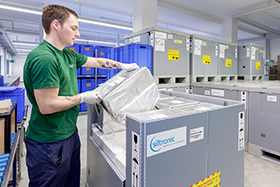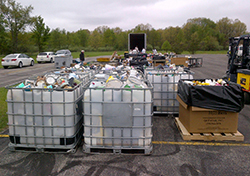Waste
Recycled Waste

In integrated production, we minimize waste by feeding byproducts back into the production loop. WACKER endeavors to avoid waste throughout a product’s entire life cycle. Groupwide, we record the volume of waste we generate according to the criteria “to be recycled” and “to be disposed of,” as well as “hazardous” and “non-hazardous.”
Due to higher production volumes, our waste has increased by 10 percent in the period under review. Additional capacity utilization at the Nünchritz site resulted in more filter and sewage sludge. Expansion measures there led to increased disposal of construction waste in 2013. In Burghausen, we recovered more energy from chlorosilane by residue incineration; we provided the cement industry with the resulting silica for further use. The causes for the waste increase in 2014 are consolidated reporting for the Singapore site and the Calvert City site expansion, where large amounts of construction waste were generated, too.
| Download XLS |
|
|
|
|
|||
|
|
|
||||
t |
2014 |
2013 |
2012 |
|||
|
|
|
|
|||
Total |
158,200 |
142,060 |
136,800 |
|||
Of which |
|
|
|
|||
Disposed of |
49,260 |
31,560 |
39,920 |
|||
Recycled |
108,940 |
110,500 |
96,880 |
|||
Or |
|
|
|
|||
Hazardous |
75,630 |
73,380 |
73,620 |
|||
Non-hazardous |
82,570 |
68,680 |
63,180 |
|||
|
|
|
||||
Waste-Reduction Projects
During the 2013/2014 reporting period, we also reduced waste with the help of projects that form part of our WOS (Wacker Operating System) program. One example is the recycling of acetic acid at WACKER POLYMERS. We operate a thin-film evaporator in Burghausen to recover acetic acid from the liquid residues of the VAM (vinyl acetate monomer) plant for complete recycling in the VAM process. This has enabled us to reduce the VAM plant’s solvent waste by approximately 15 percent.
We maintain a chemicals-exchange database. Burghausen site employees can use it to identify surplus substances, either in opened packaging drums, or in their original container. The database is a practical way to coordinate the recycling of surplus materials.
At Siltronic in Portland, we have developed a recycling process for cutting slurry, which the Siltronic production sites in Burghausen, Freiberg and Singapore use, too. Cutting slurry is added in the wire-sawing of wafers in order to ensure clean processing. It consists of a cutting fluid and silicon carbide as the cutting material. For recycling purposes, we collect used cutting slurry for external recovery companies that separate liquid and solids. The recycling companies recover 85 to 100 percent of our cutting fluid, which is then used in Siltronic production again. The recycling rate for silicon carbide is 75 percent. Any solids that Siltronic cannot use find application as blast furnace aggregates in steel smelting, for example.
Packaging and Transport
WACKER is keen to minimize the environmental impact of its packaging materials. For instance, the Siltronic division prefers reusable packaging such as the Hybox. We ship our 300 mm wafers in this type of reusable container, which is designed for transportation in hygienically sensitive areas. The Hybox has 30 percent less volume than cardboard packaging. Since the introduction of the Hybox in 2006, we have shipped 64,000 of them from the Burghausen and Freiberg sites. Thanks to this reusable design, we avoided a total of around 2,300 metric tons of waste from 2006 to 2014.

The Hybox protects 300 mm wafers during shipment. Thanks to the reusable system, 610 metric tons of packaging material were saved in 2014 alone (439 metric tons in 2013).
Proper Disposal of Neighbors’ Hazardous Waste

Adrian site employees regularly invite their neighbors to bring in their hazardous waste for recycling.
WACKER held its 17th “Household Hazardous Waste Day” for neighbors of its Adrian site in Michigan (USA) in 2014. On this day, neighbors from Lenawee county can bring in any chemical household products that are not allowed in trash cans, like (latex) paints, flammable liquids, waste oil, antifreeze, insect repellents, spray cans, alkaline and mercury batteries, fluorescent tubes and incandescent lamps. Held since 1997, this campaign run by employee volunteers has resulted in the collection and proper disposal of some 166 metric tons of hazardous waste at Adrian.